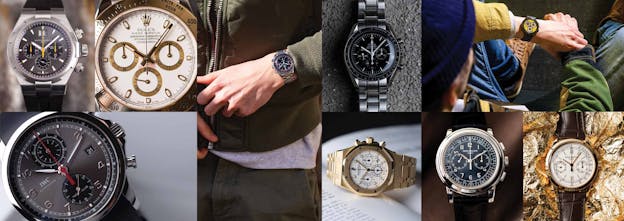A Chronograph History Lesson: A Matter of Timing
Turn to a watch enthusiast one day, hopefully catching them off guard, and ask them to name a complication. I’d put money on the fact that 9 times out of 10 the answer you’ll get is “chronograph”. It’s a beloved complication among the majority, and quite frankly one of the few remaining complications with practical application. You see, a moonphase serves no practical purpose, annual and perpetual calendars can be made obsolete by glancing at the lock screen of your smartphone, and minute repeaters–well those are just awesome toys built for our amusement.

Why a Chronograph is Useful
Actually timing something from your wrist is inherently practical, whether you’re cooking something, waiting for a laundry cycle to end, or seeing how long it takes to get from your door to the gate for your next flight (yes, I do all of the above), using a wrist-mounted timekeeper makes more sense than unlocking your phone, opening the clock app, selecting stopwatch, starting it, and then repeating those actions again as you reach the end of your timing cycle. While not every brand produces a chronograph, there are countless options out there, and the complication has a rich history that built the legacy it rests on today.

The Beginnings
For some time it was firmly believed that Nicolas Rieussec was responsible for the creation of the chronograph in 1821, however, 2012 saw the rewriting of horological history books. The first proper chronograph actually came from Louis Moinet — a historically significant watchmaker whose name now exists on a niche contemporary watch brand. Though it has been refined significantly over the years, this first piece was incredibly ahead of its time, running at 216,000 vibrations an hour–thus being capable of timing 1/60th of a second.
After Moinet came Rieussec who first properly used the name chronograph for the complication. Rather than being a handheld device, Rieussec’s chronograph was built into a box and was capable of recording its timings on paper. Interestingly, the timing box was created as a horse race timer, which set the tone for the complication’s many years as a timing device for racing in countless forms.

Making the transition to the wristwatch was a much bigger step and one that took nearly 100 years to achieve. Longines proved first to the punch in 1913, with their first wrist-mounted chronograph designed as a monopusher. This mechanism design, though fundamentally simpler than the conventional two pusher chronograph setup, has become oddly sought after these days, with modern monopushers regularly fetching a premium over their siblings.
It wasn’t long after (1923 to be precise) that the next prize innovation arrived to the chronograph–the arrival of the first split-seconds chronograph. As it stands the Patek Philippe 1923 Officer is being referred to as the “earliest known” split chronograph in existence. Sold in 1923, it’s said that it took 20 years to manufacture. Curious about the choice of words with this one, as it leads to a suspicion that there may be an earlier example resting somewhere yet to be uncovered.
The Modern Marvels in Chronograph Watches
Though the groundwork was laid over a century ago now, there have been a number of chronographs to launch since that time that have gone down as icons in the history books for a variety of reasons, as much from a technical perspective as for the stories that came with their origins. To go into every iconic chronograph over the last century would be a grave undertaking, so instead, we are selecting a trio of pieces that changed the chronograph world in some form or fashion.

The Omega Speedmaster’s deployment to the moon didn’t necessitate the reinvention of the chronograph, but in one fell swoop, it did manage to make the complication that much more “mainstream” as it were. First launched in 1957, the first trip a Speedmaster took into orbit was in 1962 as personal property on Mercury 9 missions, and then between 1964 and ‘65, NASA put a number of chronographs from different brands through rigorous testing before siding with Omega as the official watch of the organization.

Though it didn’t go to space, Zenith’s launch of the El Primero in 1969 set a new benchmark for precision. Running at 5 Hz (or 36,000 vibrations per hour), El Primero chronographs time 1/10th of a second. They’ve proven incredibly reliable over the years, and though they somehow aren’t spiking in value the way some other vintage watches are, they’re a great buy whether recent or vintage. A real testament to the quality of their movement design is the fact that Rolex opted to modify the El Primero caliber to fit into the beloved Daytona from roughly 1988 to 2002.

Fast forward to 2011 and we have a very unique watch that set another milestone, though one that doesn’t get nearly as much credit as it deserves. The TAG Heuer Mikrograph Chronograph is the first integrated chronograph caliber to use two separate balance wheels–one for time indication and one for the chronograph itself, running at 28,000 vph and a whopping 360,000 vph respectively–and capable of measuring time down to 1/100th of a second via a central seconds hand. Now, going back to our earlier conversation about practicality; no, this watch is not particularly practical. That said, it is such an interesting showcase of precision and movement capabilities. Priced at $50,000, this new innovation didn’t come cheap, however being part of the LVMH group this watch also laid the groundwork for what we now know as the Zenith Defy 21, which uses a caliber of similar design in a very well-designed package closer to the $10k mark.

